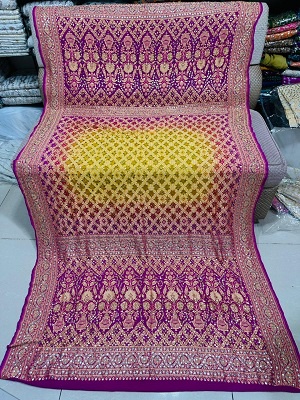In the rich tapestry of Indian textiles, Mukesh and Kamdani dupattas stand out as timeless treasures, weaving together the threads of tradition, craftsmanship, and artistic expression. These handcrafted marvels have transcended generations, adorning the attire of Indian women with a touch of opulence and grace. In this exploration, we delve into the fascinating world of Mukesh and Kamdani dupattas, unraveling the history, craftsmanship, and the enduring allure that makes them an indispensable part of every discerning wardrobe.
A Glimpse into the Past:
The roots of Mukesh and Kamdani work can be traced back centuries, to the Mughal era, when art and culture flourished in the Indian subcontinent. The Mughal emperors were patrons of the arts, and their influence seeped into every facet of society, including the textiles. Mukesh and Kamdani work, characterized by intricate embroidery and metallic embellishments, were born during this golden period of Indian history.
Mukesh work involves the use of metallic wires, often silver or gold-coated, to create a shimmering effect on the fabric. Kamdani, on the other hand, employs small pieces of metal, beads, or spangles to enhance the embroidery. Both techniques require immense skill and precision, and the artisans who practice these crafts are the torchbearers of a tradition that has been handed down through generations.
Craftsmanship:
The craftsmanship involved in creating Mukesh and Kamdani dupattas is nothing short of awe-inspiring. The process begins with selecting the finest quality fabric, often silk or chiffon, which serves as the canvas for the artisan's creativity. The fabric is then stretched taut on a frame, and the meticulous work of embroidery begins.
Artisans painstakingly stitch the metallic wires or embellishments onto the fabric, forming elaborate patterns that range from intricate floral motifs to geometric designs. The precision required in this process is extraordinary, and it is this attention to detail that sets Mukesh and Kamdani work apart. The use of metallic elements imparts a regal sheen to the fabric, creating a play of light and shadow that adds to its allure.
The Timeless Allure:
What makes Mukesh and Kamdani dupattas truly timeless is their versatility and ability to transcend fashion trends. These handcrafted pieces are not merely accessories; they are a testament to the rich cultural heritage of India. Whether paired with a traditional saree, a salwar kameez, or even a contemporary outfit, Mukesh and Kamdani dupattas have the power to elevate any ensemble to a new level of sophistication.
In an era where fast fashion dominates, these handcrafted treasures serve as a reminder of the importance of slow, sustainable fashion. Each Mukesh and Kamdani dupatta is a unique work of art, crafted by skilled hands that have honed their expertise over years. The time and effort invested in creating these pieces contribute to their enduring appeal, making them a cherished possession passed down from one generation to the next.
Modern Interpretations:
While Mukesh and Kamdani work have deep roots in tradition, contemporary designers have successfully infused a modern sensibility into these age-old crafts. The juxtaposition of traditional embroidery with unconventional fabrics and designs has given rise to a new wave of Mukesh and Kamdani dupattas that cater to the tastes of the modern, cosmopolitan woman.
Designers experiment with colors, textures, and patterns, offering a wide array of options for those who seek to embrace tradition while making a style statement. Mukesh and Kamdani dupattas are no longer confined to traditional occasions; they have seamlessly integrated into the wardrobes of women who appreciate the beauty of handcrafted textiles in their everyday lives.
Preserving Heritage:
As we celebrate the beauty of Mukesh and Kamdani dupattas, it is crucial to acknowledge the challenges faced by the artisans who dedicate their lives to preserving this rich heritage. The advent of machine-made alternatives and the pressures of mass production pose a threat to these age-old crafts. Supporting and promoting the work of these artisans is essential for ensuring the continuity of Mukesh and Kamdani traditions.
Conclusion:
In the tapestry of Indian textiles, Mukesh and Kamdani dupattas weave a story of tradition, craftsmanship, and enduring elegance. These handcrafted marvels, born from the rich cultural heritage of India, continue to captivate the hearts of women across the globe. As we embrace the allure of Mukesh and Kamdani work, let us also recognize the importance of preserving these traditions, ensuring that future generations can continue to bask in the timeless splendor of these exquisite creations.


No comments yet